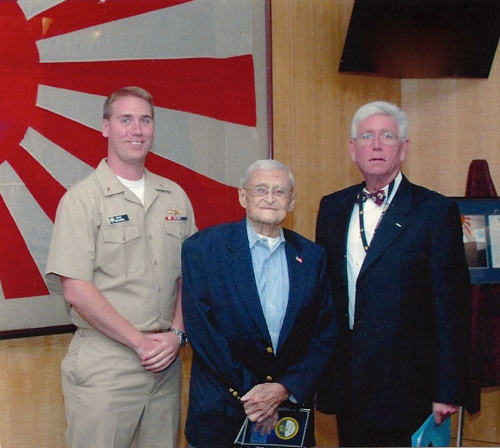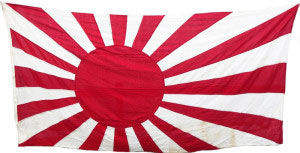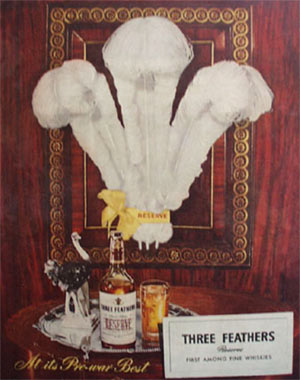Three Feathers and a Flag

(RADM Donald “Mac” Showers is flanked by a pair of Socotras in the Hoyer Foyer at the Office of Naval Intelligence in Suitland, MD, on the occasion of Mac’s donation of the battle flag of the IJN Battleship Nagato in 2012. The Foyer is so named irreverently in honor of the former House majority Leader Steny Hoyer, D-5th, for his efforts to have the new ONI building located in his district. Photo USN).
The proud battleship Nagato would not get underway for the remainder of the war. She was pier-side at the Yokosuka Naval Armory, heavily concealed with camouflage nets and plywood structures in July of 1945. Soon-to-be Fleet Admiral William “Bull” Halsey had a personal thing about the ship from which the orders to attack Pearl Harbor had been issued, and he directed the THIRD Fleet to conduct a series of air raids on the base in order to put her underwater. Task Force 38, under Vice Admiral John S. McCain, was the blunt instrument of choice, and included nine fleet carriers, six light carriers, their escorts and a thousand aircraft. On 10 July TF 38 pilots struck airfields around Tokyo and claimed to have destroyed 340 Japanese aircraft on the ground and two in the air. No Japanese aircraft responded to this attack as they were being held in reserve to mount large-scale suicide attacks on the Allied fleet during the impending invasion of the Home Islands. Mac Showers was unperturbed by the revisionist history about the use of the atomic bomb in later years. he and his pal Hal Leathers in the Estimates Section of the Forward Headquarters on Guam were reasonably confident that a million Americans would be killed or wounded i the assault, never mind the military and civilian population of Japan who stood in their path.
The strikes against Yokosuka were Nagato’s last combat action, mostly serving as an American target. Only two bombs actually hit the ship. One impacted the 01 deck aft of the mainmast, port side. It detonated at the base of the Number Three turret, and the occupying Americans of the Naval Technical Group marveled that although it had distorted the barbette, the turret was undamaged. The blast scar left a nearly perfect image of the rising sun flag on the surface of the armor plate. Worse, it had penetrated the ceiling of the lightly armored deck near the wardroom, killing over twenty men.
There is some lingering controversy about a possible third hit. Something, possibly a five-inch rocket, tore through the port side stern and passed through the Admiral’s mess and out the other side without exploding.
The techincal team reported there was a gouge on the surface of the dining table, and markings that looked like they might have been made by teeth. The team was astonished that no one was killed there.
Between the two bombs, Nagato lost thirty-five officers and men.
The Allies lost fourteen planes and eighteen fliers, most of them over the harbor.
That was the last action of the war for the old battleship. Rear Admiral Ikeuchi Masamichi was recalled from retirement to assume command in late July.
The newest Special Weapons of the Allies were employed against Hiroshima and Nagasaki on August 6th and 9th of August, respectively. At noon on the 15th, the Admiral called the crew to quarters to listen to the unprecedented broadcast of the Emperor, calling on his subjects to end hostilities.
On the 20th, Captain Sugino Shuichi arrived on the ship and there was a small change of command ceremony to make him the last Japanese commander. The position she occupied at the pier would be needed for other uses. Under his direction, Nagato was relocated to the Number One buoy in Yokosuka’s inner harbor.
On the 28th, the Americans arrived. There are several accounts of who “captured” Nagato. The official legend is that “a boarding party composed of about 35 men from the USS South Dakota, symbolically on surrender day (Sep 2nd). The version some like to believe goes like this: “Many artifacts were brought back aboard USS South Dakota. The battle flag of the Nagato was acquired at this time.”
Charles M. Cavell, QM1, USN, preserved a Nagato flag and donated it to the crew of USS South Dakota, and then the USS South Dakota Memorial in Sioux Falls, South Dakota.
Other credible reports of the disposition of the flag locker include this entry from the diary of the Skipper of the USS Buchanan, CDR Daniel E. Henry, USN, who reported this on August 30:
“Battleship Nagato boarded; San Diego docks at Yokosuka Naval Yard; first sighting of POWs; transferred 40 POW correspondents with horrifying reports on POW treatment. Awakened at 0700 and found the DD Nicholas (DD-484,, captained by D.C. Lyndon, my first classmate at the Naval Academy) was waiting to relieve us. They had met a Jap DD on the 27th and taken some Japs to Admiral Halsey on the Missouri. We proceeded to anchorage but found our berth occupied by transports busy sending Marines ashore at Yokosuka. We anchored and watched the show. American planes are landing at the field at Yokosuka, says the commodore, but I am not sure.
0830 our APD (USS Horace A. Bass (LPR-124)) went alongside the BB Nagato, boarded, hauled down the Jap flag and hoisted ours. They report Nagato #10 boiler still warm, a diesel OK as is the anchor engine and steering gear. Other steam lines cut.”
I think that may have been the first boarding right then. Others followed over the next few days.
We talked about the whole thing at Willow. There was more than one flag from the battleship, and our pal Mac got one of them. Now it is at ONI, and it hangs in a place of honor at the Office of Naval Intelligence out in suburban Maryland. ONI is a gleaming building of steel and glass, one of the last of the Cold War buildings to be erected to replace the crumbling old buildings that had served in World War Two.

(This flag from Nagato was brought home by a Horace A. Bass crew member named William Wilson. It measures an impressive 134 inches by 69 inches, and was sold at auction by Mark Lawson Antiques in Sarasota, NY, for $1,800 in 2013. Photo Mark Lawson).
In the course of its construction, a former Director of Naval Intelligence had the high-security facility designated an official depository for the combat art commissioned by the Government. Accordingly, there are some spectacular original paintings dotting the corridors between the anonymous cipher-locked officers.
One of Nagato’s Rising Sun Naval ensigns is there as well, in a wooden frame, preserved behind glass.
It is a centerpiece that connects the young sailors and officers of ONI with their history. I asked Mac how the flag came to be in his possession as we sat at the Willow bar one lazy afternoon. He summarized it this way:
“By 1945, I was with Fleet Admiral Nimitz at the forward headquarters at Guam, doing estimates for the carnage that would come with the invasion of the Home Islands. I was slipping target nominations on the sly to General Curtis “Iron Pants” LeMay. Admiral Nimitz took his Intelligence Officer Eddie Layton- my Boss- to the surrender ceremony on the Missouri. Eddie felt bad that none of the younger officers got a chance to see it, after more than four years serving in the conflict. He cooked up a semi-valid requirement to send me with a courier package to Yokosuka just a few days after the surrender, and I jumped at the chance to go and see up close just what we had done.”
“One of our shipmates was on a ship out there, and I decided to take him some whiskey, thinking that would something useful. I went to the wine mess on Guam and got a bottle of Three Feathers Whiskey to tuck in my bag, and caught a flight on a seaplane toYokosuka.”
“I have never heard of the brand,” I said. “Did it go well with Lucky Strike Greens?”
“As a matter of fact, it did,” smiled Mac. “So, I delivered the package and walked around the base, marveling at the idea the conflict was really over. I could not find my friend, and didn’t really want to take the whiskey back to Guam with me. That is when I saw Nagato out at the buoy in the harbor. She was the last of the big battleships in port.”
“My flag came from a Marine sentry on the Yokosuka docks (about 4 or 5 Sept. ’45) who told me he was a member of the boarding party on Nagato, and that his duty station was the flag locker. With this convenience, he said he had “liberated” four Rising Sun flags, two large and two small. Desiring such a souvenir, I told him I only wanted one and would take a small one. Then we negotiated the price and the whiskey trade, and he disappeared for a few minutes.”
“He returned with a brown paper package that looked about the right size. I tore open just a bit of the wrapping to confirm it was the Rising Sun design, we completed the deal, and I then caught my boat for the seaplane tender from which I would depart the next morning for my return to Guam. I didn’t open the package until I was back in my private quarters on Guam, and then was pleased with what I had. I showed it only to Captain Eddie Layton, who confirmed I had a genuine souvenir.”
“There’s more that can be told, but that’s the most authentic account of my procurement.”
“In summary and in short, I’m sure there are other Nagato flags, but mine was clearly used, obviously had flown from the ship, and was from a believable source. More than that I cannot say. “
“As I look back on the encounter and the bargain I struck, I now believe I could have talked the Marine out of all four of his flags in trade for the bottle of Three Feathers Whiskey I provided. But I was satisfied, I’m sure the Marine was, and I have no idea how he disposed of the other three flags.”
Nagato was systematically plundered for the next few weeks, and formally stricken from the Navy List on the 15th of November 1945. Rust streaked the hull and the proud pagoda mast, and gulls of the Sagami Wan rendered their opinion of the works of man in streaks of white down the superstructure.
But that was not the last of the story, nor even the best part. That was going to come when the Last Battleship got a new crew. An American crew, and in the process, the enlisted ship-fitters discovered the Nagato’s store of grain alcohol, which may not have been Three Feathers, but suited them just fine on the last deployment of the battlewagon.

Copyright 2015 Vic Socotra
www.vicsocotra.com
Twitter: @jayare303
